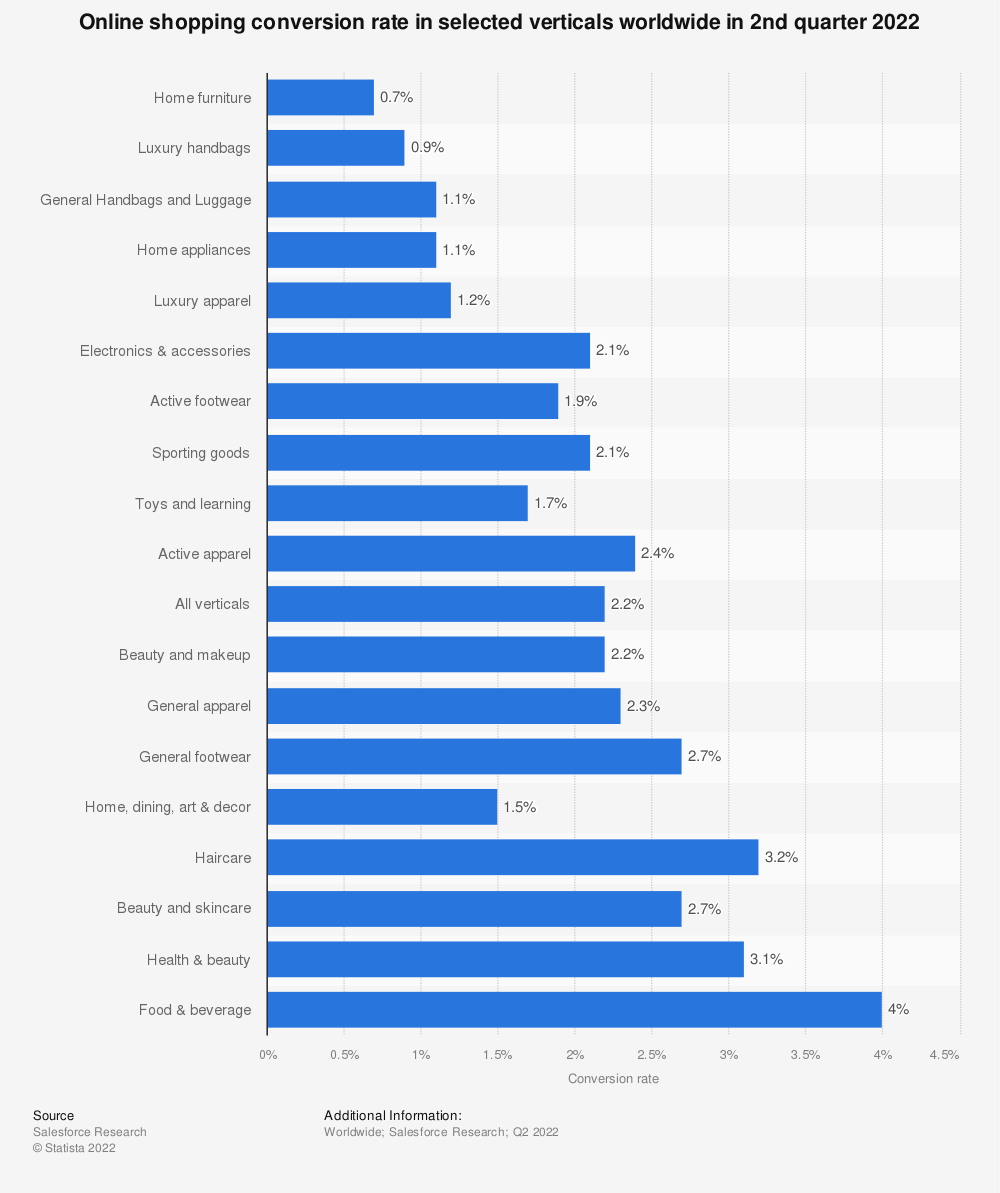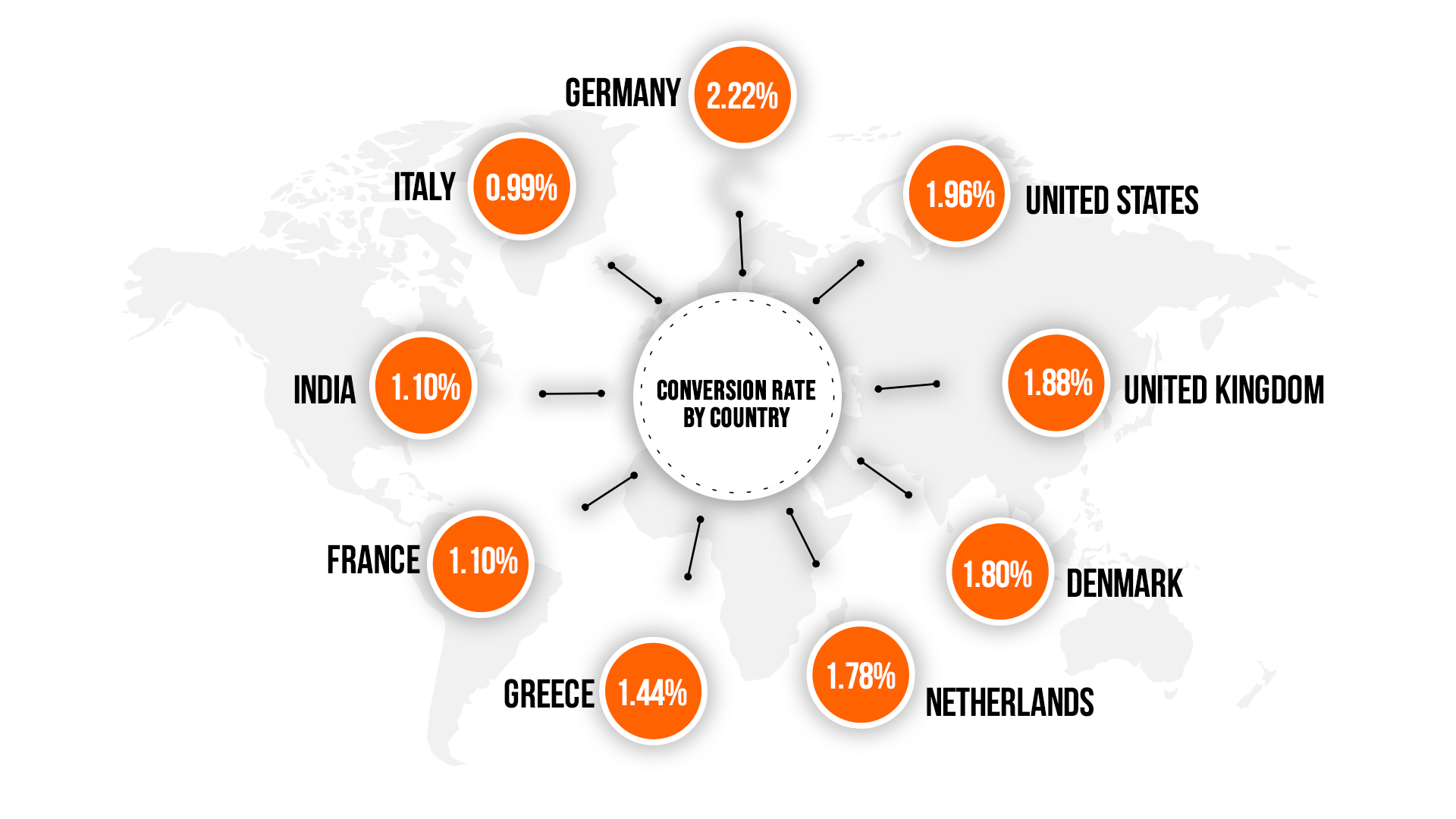Put in simple words, conversion rate in digital commerce is
the percentage of online visitors that purchased something
from a website, against those who just visited and left. Apart
from direct sales, organizations may also consider products
added to cart, products added to wish lists, email signups,
social media shares etc. and other KPIs to define success. At
its core, conversion comes down to this simple formula:
Conversion rate = Number of conversions / Total no. of
visitors x 100
Conversion rate optimization (CRO) refers to a series of steps
taken to improve the online experience and meet specific KPIs
– which usually comes down to sales. Conversion rate
optimization can be carried out on the front end (on landing
pages, category pages or other touchpoints), or more
organically with SEO, product data optimization, site search
optimization etc.
What does a good conversion rate look like?
This is where we get into the business end of understanding
conversion. On average, digital conversion rates round up to
anything between 2.5% and 3%. From this point of a view, a 3%
conversion is something you should consider as a starting
point for your CRO activities.
What you can consider a good conversion depends on a whole
variety of factors. One of them is product verticals.
Online shopping conversion rate in selected verticals
worldwide in 2nd quarter 2022 (Source: Statista)
As you can see in the above numbers from Statista, the average
conversion rate differs from category to category. In some
instances, you will see higher conversion in products that
have a natural propensity for high demand; for example, food.
In others, you will see a fluctuation in average values
depending on the time of the year, seasons, trends, and a
whole lot of other variables.
Then again, another relevant variable to consider is
geography. Conversion rates may be higher in some countries
owing to a more robust supply chain system, easier access to
affordable logistics, higher internet availability and so on.
Here’s a breakdown of conversion by country, which gives a
better understanding of the above point:
Other metrics that impact conversion
Beyond the core principles of conversion, there are other
metrics that impact overall conversion. They include:
-
Bounce Rate:
The percentage of visitors that leave a website after
viewing a single page. This is usually indicative of
customers not finding what they’re looking for, and not
gaining the confidence to further their search on a website.
This could also be impacted by cluttered design, slow
loading time, too many popups, SSL warnings and so on.
-
Exit Rate:
This refers to the percentage of visitors that leave a
particular page after browsing a few pages on a website.
-
Click-Through Rate:
This metric refers to the proportion of visitors that click
a hyperlink to a website. The more the clicks on the
hyperlink, the higher the click-through rate.
-
Average Session Duration:
The engagement metric gives an idea of how long visitors
spend on a website. A high bounce rate usually converts to
low session duration which is indicative of a lack of
engaging content or relevant information.
-
Average Page Depth/Pages Per Session:
This metric gives the number of pages a visitor lands on
before exiting. It gives the total number of page views per
any given session. Higher pages per session is a
double-edged sword, as it could either indicate better
engagement, or a lack of clarity (especially if these views
lead to no conversion).
The basics of conversion rate optimization
At a higher level, websites can be optimized in various ways
to drive conversion. Simple yet effective, these steps are
based on basic buying behavior and habits.
-
Design your website to grab visitors attention instantly
- Improve site speed
- Offer competitive pricing
- Offer free shipping if possible
-
Test and tweak the checkout process for the best results
- Use live chatbots
-
Use SSL certifications and let your customers know your site
is safe
- Be transparent when gathering customer information
- Focus on SEO and better on-site findability
- Design the checkout process to be uncomplicated
- Show shopping cart contents clearly
- Give customers the option to checkout as guests
- Leverage testimonials and reviews
-
Ensure that CTA buttons (“add to cart”, “checkout” “pay”,
etc.) are easy to spot
- Use CTA buttons smartly, when they matter the most
- Have a clear and supportive policy for returns
- Optimize for mobile
- Offer personalized buying experiences
- Test, test, test again
However, as mentioned, these steps are mostly superficial
low-hanging fruits. They are easy to implement and achieve but
don’t always necessarily hold the key to conversion
optimization. And this is where sound product data comes to
the fore. Have the most attractive website with good speed,
secure browsing, clear CTA – the works – and yet, if your
product data is lacking, the buying journey is sure to fall
flat at some point.
Leveraging product data to drive conversion rate optimization
Maximizing the value of product data is at the core of all
conversion rate optimization activities. Why? Because it gets
to the heart of the matter and drives a better customer
experience organically. While high quality data may not seem
directly attributable to high conversion or low bounce rates,
product data is really the foundation on which all conversion
rate optimization activities can be built on. Here’s how:
-
Higher Quality Content:
Conversion is nothing more than a quantifiable metric that
represents customer trust. And this trust is built on
complete, clear and up-to-date information that best
describes a product. Sound product data management enables
organizations to put their best foot forward with product
data, irrespective of the number of stakeholders and
touchpoints in the buying journey. With the right flags and
standards in place, businesses can easily deliver
compelling, high quality product stories each time, every
time. And this is achievable with minimum manual
intervention.
-
Improved Data Modelling:
The organization of product data is just as important as
product data itself. And this is where site structure,
taxonomy and attribution play a key role in driving customer
experience. Site structure defines how users interact with a
website, taxonomy defines how they navigate through a
website to find a product, and attribution further refines
the process to find products with particular attributes.
With data management, organizations can optimize all these
aspects to streamline the buying journey and, in turn,
improve the rate of conversion.
-
Better Engagement:
Once core data-related issues are taken care of,
organizations can then focus on improving engagement and
value. The best example of this is engagement and conversion
optimization with
digital asset management
(DAM). DAM allows organizations to take things to the next
level with value-added engagement points such as 360-degree
images, videos, AR experiences, and lots more. Good product
data management ensures that these assets reside in a
centralized repository with version and access control, and
easy access to teams across functions.
-
End-to-End Control Over Product Data:
Automated syndication ensures that irrespective of the
number of players in the data journey, product data adhere
to preset standards and rules. Incorrect data, incomplete
data or insufficient data – it is all flagged automatically
and dealt with at source, so when customers finally interact
with the product, it is up to the mark, irrespective of the
channel of interaction. Automation ensures that
organizations can achieve cross-channel data quality with
lesser manpower, and that this quality is maintained in
upstream and downstream operations.
-
Improved Time-to-Market:
The faster your customers see your product or service, the
more likely they are to buy it. And when speed at scale
becomes the norm, this has a direct impact on expectations
and loyalty. So, most naturally, improved time-to-market
impacts conversion as well. From artificial intelligence
(AI) and machine learning (ML) to robotic process automation
(RPA), the world of product data management is buzzing with
opportunities for innovation and improvement. These
advancements have a direct and measurable impact on both,
time-to-market, and eventually, conversion as well.
How product-data-driven CRO helps your business increase
conversion
Product-data-driven CRO enables businesses to improve their
website functionality towards better conversion rates. It
enables businesses to:
-
Improve ROI :
Even with the same amount of traffic, improving product data
quality can go a long way in converting existing visitors to
buyers.
-
Enhance UX:
Product-data-related improvement made at every touchpoint of
the buying journey culminates into better user experiences.
-
Lower Cost Per Acquisition:
Getting more customers to convert with better product data
is an organic process, so finding new customers and
increasing conversion is a direct by-product of these
practices, not an additional cost factor.
-
Boost SEO:
Better product data management aimed at CRO is also
beneficial from the SEO point of view. Search-centric
product data that works well with customers on a website,
will also naturally show better results on search engines.
-
Increase Customer Lifetime Value:
Reliable, relevant and accurate product data builds trust.
And when this quality of data is delivered consistently, it
also boosts customer lifetime value.
If you’re wondering how to get started with better product
data management for CRO, get in touch with our experts at
Amaze PXM!
Schedule an Introduction


